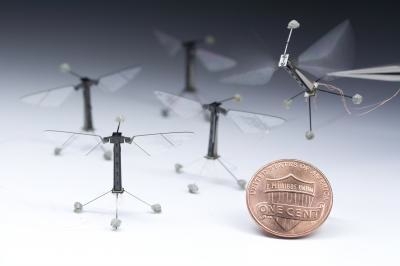US researchers have demonstrated a tiny robotic flying insect that could lead to a new generation of miniature drones.
The RoboBee developed at Harvard University can flap its two wafer-thin wings 120 times per second, almost faster than the human eye can see and representing a breakthrough in piezoelectric movement.

The developers say the project could lead to tiny unmanned aerial vehicles (UAVs) for environmental monitoring, search-and-rescue operations or crop pollination, but that the materials, components and manufacturing techniques developed along the way could prove even more significant.
‘This project provides a common motivation for scientists and engineers across the university to build smaller batteries, to design more efficient control systems, and to create stronger, more lightweight materials,’ said principal investigator Prof Robert Wood, in a statement.
‘We had to develop solutions from scratch, for everything. We would get one component working, but when we moved onto the next, five new problems would arise. It was a moving target.’
Despite its name, the insect was inspired by the biology of a fly. It measures half the size of a paperclip and weighs less than one tenth of a gram. Its small size meant the researchers had to develop an alternative to traditional robotic motors.
‘Large robots can run on electromagnetic motors, but at this small scale you have to come up with an alternative, and there wasn’t one,’ said co-researcher Kevin Ma.
The solution was to develop piezoelectric actuators - strips of ceramic that expand and contract when an electric field is applied - with thin hinges of plastic embedded within the carbon-fibre body frame to serve as joints.
Each wing is controlled independently in real-time to counter small changes in airflow that can have an exaggerated impact on stability.
The insect also took advantage of a “pop-up” manufacturing technique developed by Wood’s team in 2011: sheets of various laser-cut materials are layered and sandwiched together into a thin, flat plate that folds up like a child’s pop-up book into the complete electromechanical structure.
The researchers said this created a relatively fast, step-by-step process to replace what would otherwise be a drawn out manual procedure and allowed use of more robust materials in new combinations, while improving the overall precision of each device.
‘We can now very rapidly build reliable prototypes, which allows us to be more aggressive in how we test them,’ said Ma, adding that the team has gone through 20 prototypes in just the past six months.
In order to make the robots fully autonomous, the researcher still have to develop a small-enough energy storage system such as a high energy-density fuel cell that will enable RoboBee to fly without being attached to a very thin power cable.
The team, which includes researchers from the Harvard School of Engineering and Applied Sciences (SEAS) and the Wyss Institute for Biologically Inspired Engineering, published a paper on their work this week in the journal Science.




Project to investigate hybrid approach to titanium manufacturing
What is this a hybrid of? Superplastic forming tends to be performed slowly as otherwise the behaviour is the hot creep that typifies hot...